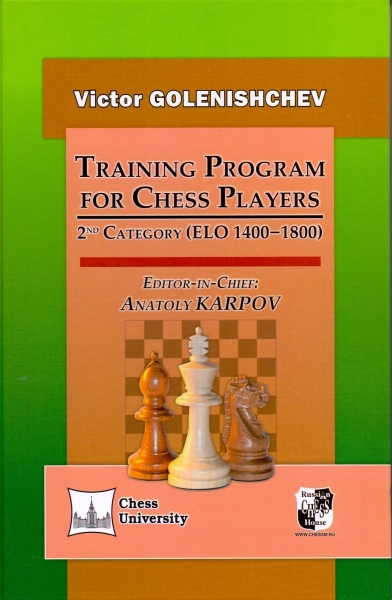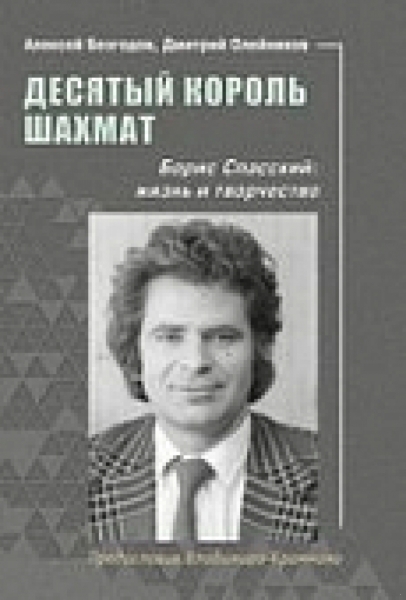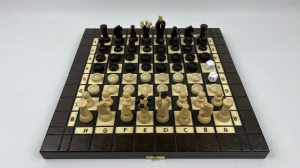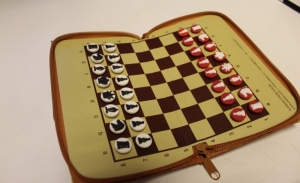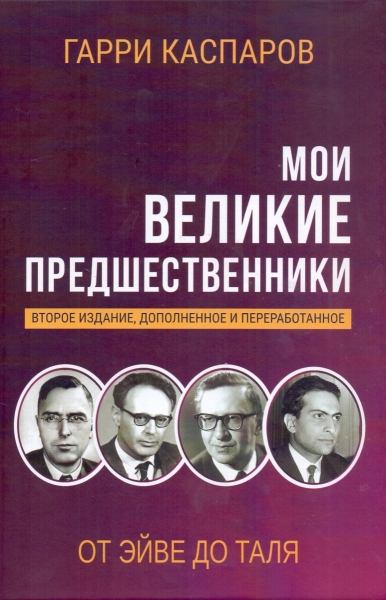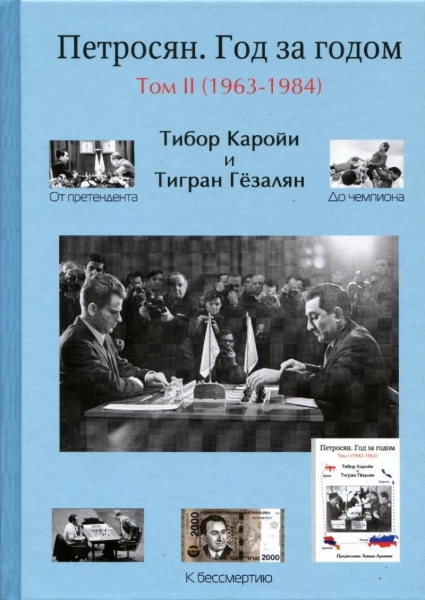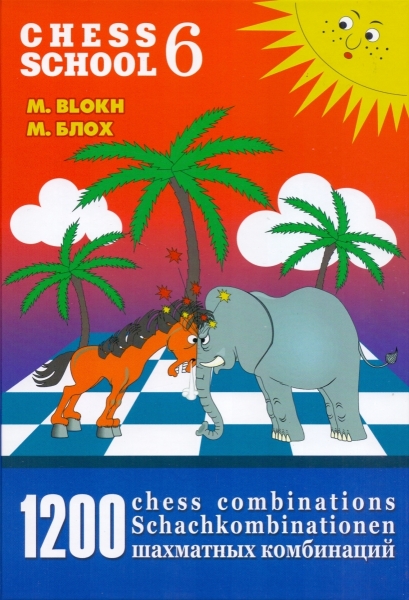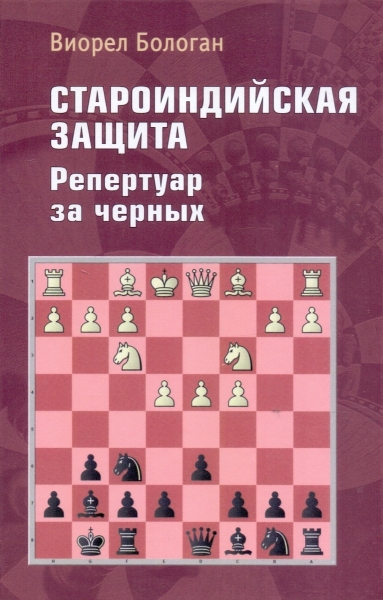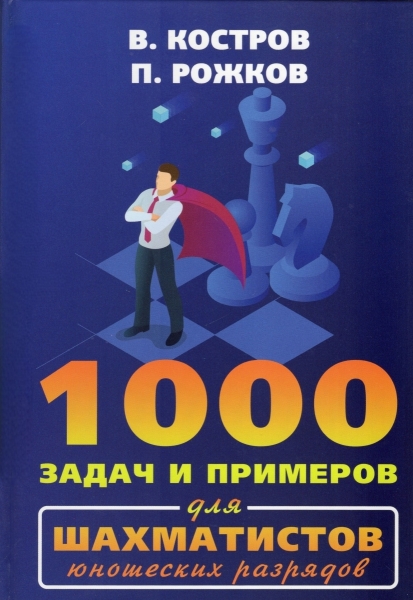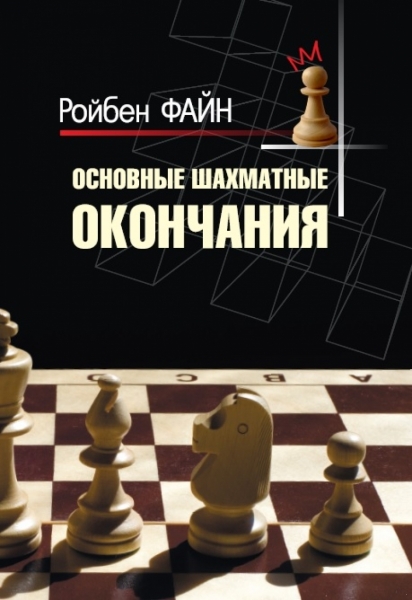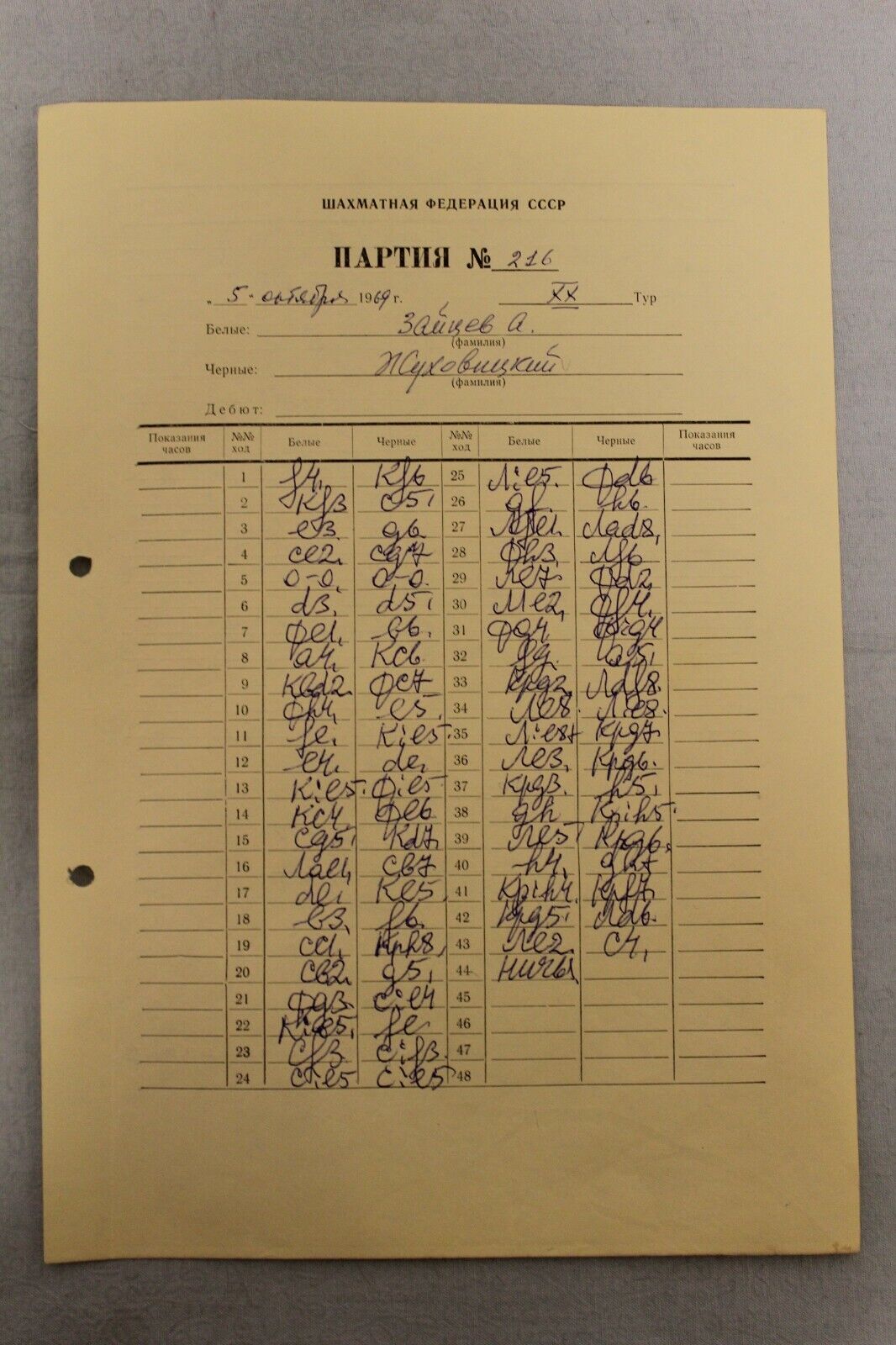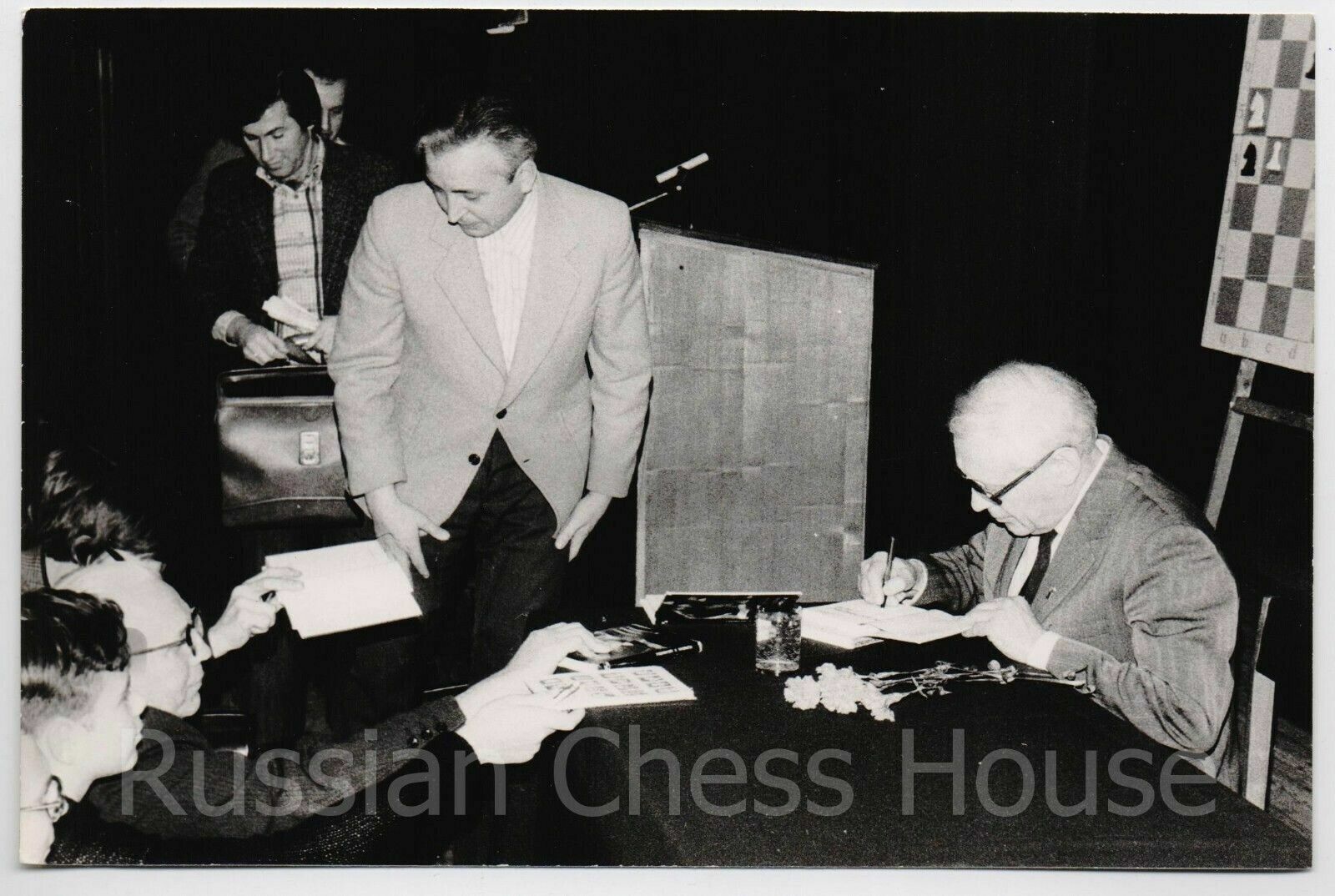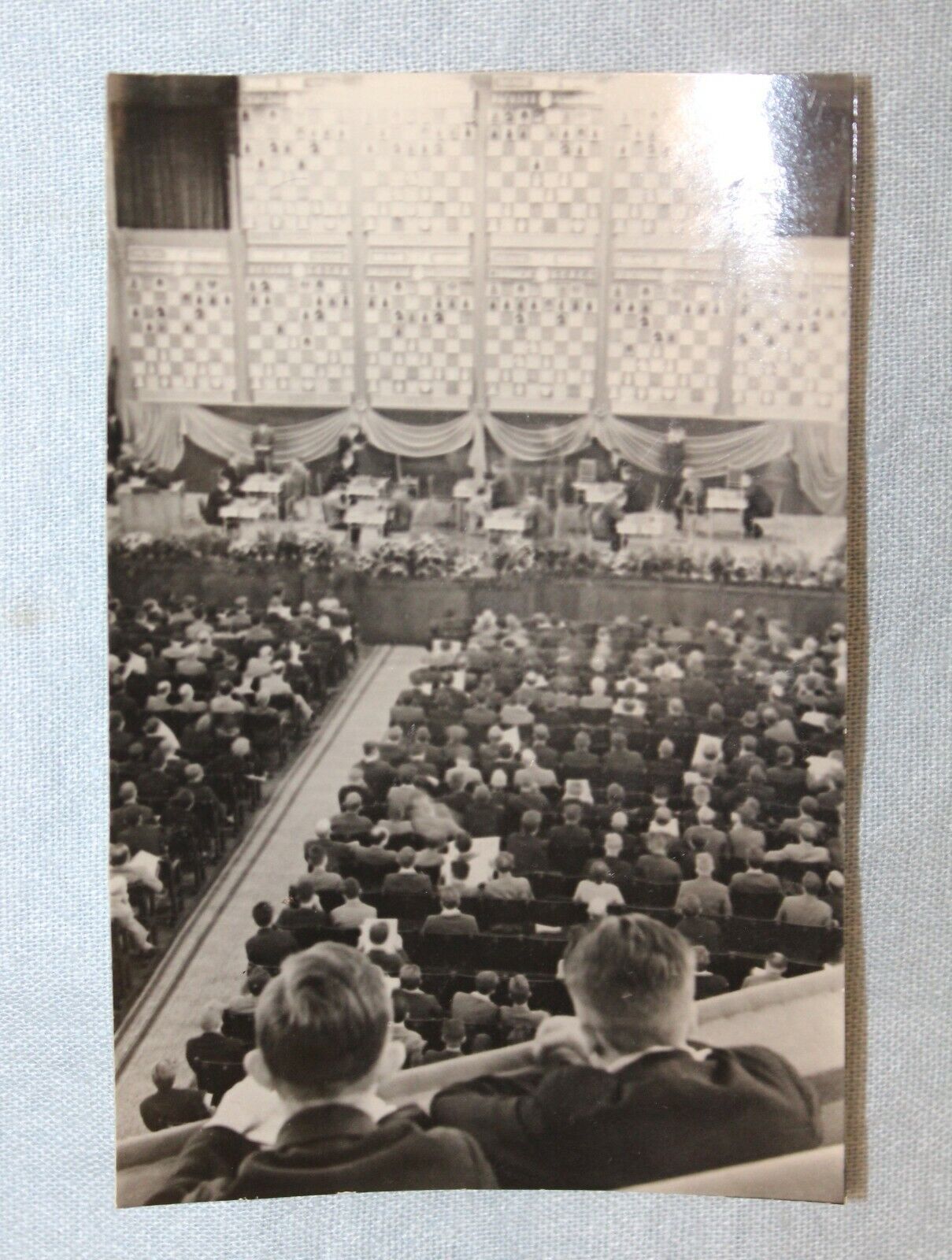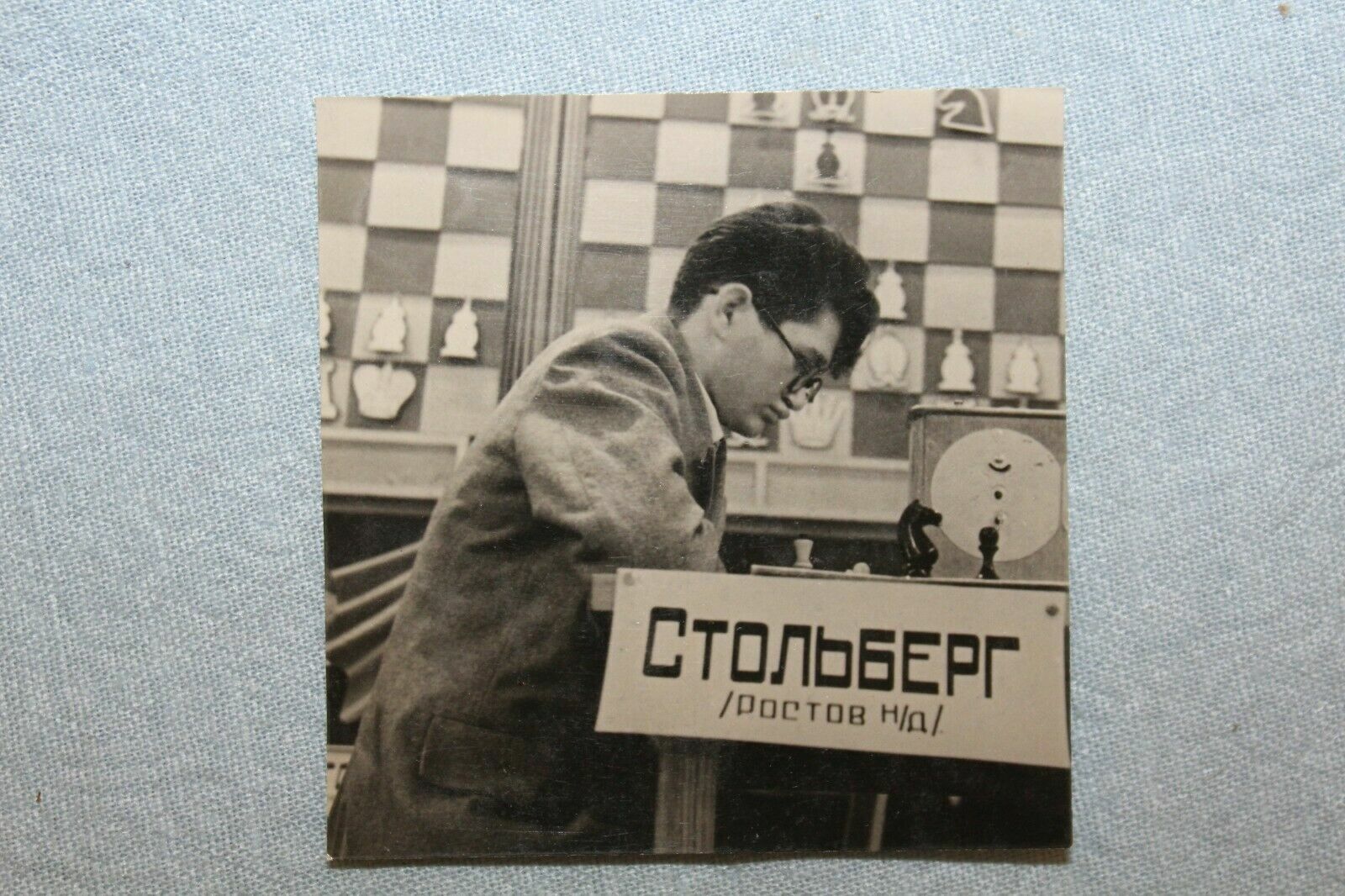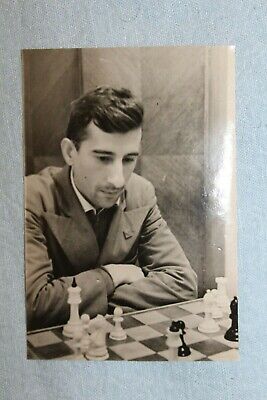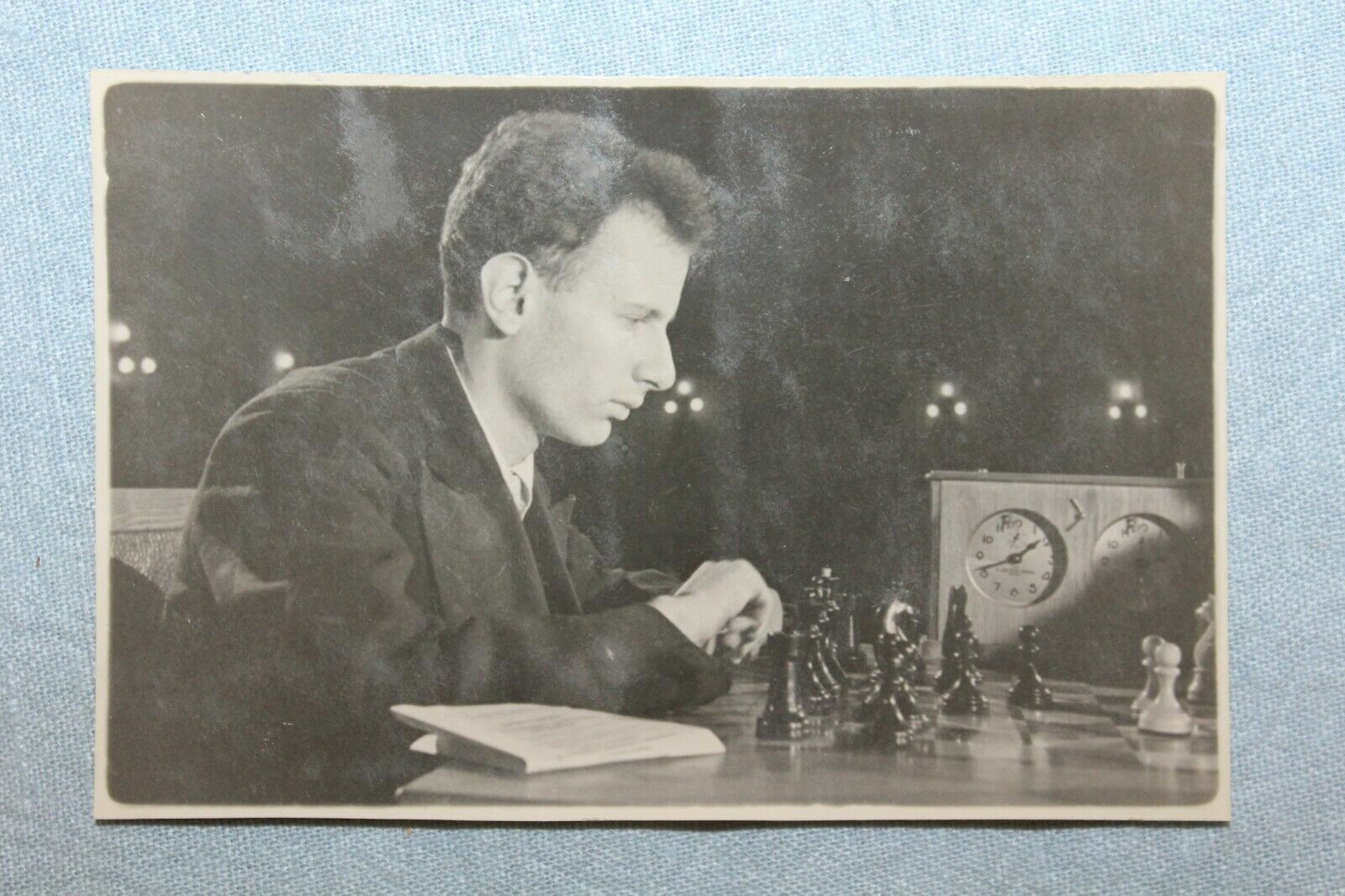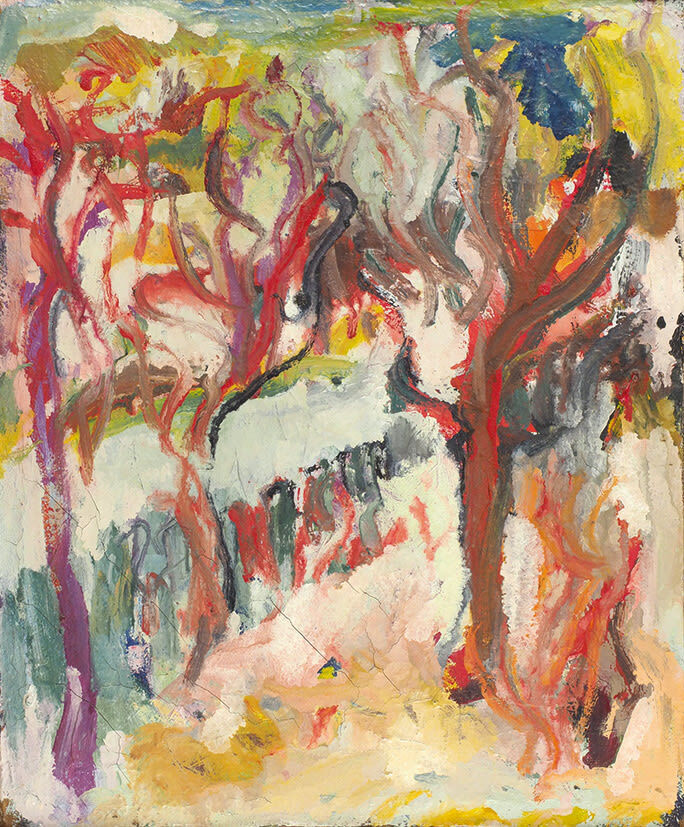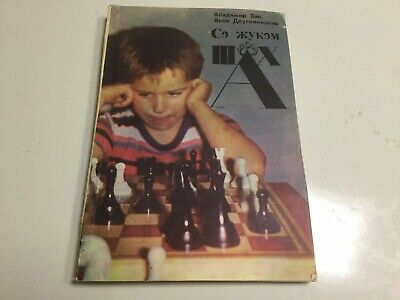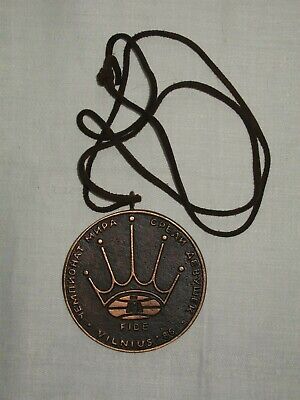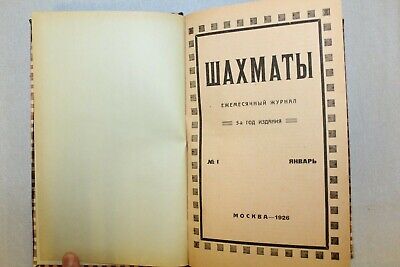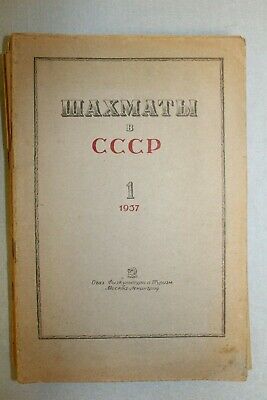eBay items
-
34.00 $
Aleksandr Zaitsev – Samuil Zhuhovitsky. Score sheet of Zhuhovitsky Soviet chess score sheet from the 37th Chess Championship which was held in Moscow September 6 – October 12 1969. Tigran Petrosyan won an additional match for the title of champion (Moscow, January 19-29, 1970). The championship was also a fide zonal tournament. Polugaevsky, Geller, Smyslov and Taimanov won the right to participate in the interzonal tournament. The latter in the final round effectively won his "party of life" from LutikovАрт ПК 2
-
30.00 $
Soviet Photo: Mikhail Botvinnik University of Chess Culture. After the lecture of Mikhail Botvinnik Photographer: M.Rabkin Dimensions: approx. 18 * 12 cm. Art PK7
-
35.00 $
General view from the hall of the Moscow conservatory. 1940 ORIGINAL SOVIET CHESS PHOTO FROM 12TH USSR CHESS CHAMPIONSHIP IN 1940 YEAR. SIZE OF THE PHOTO – 8,3 cm x 5,4 cm 12TH SOVIET CHESS CHAMPIONSHIP: This is a photograph from the famous 12th Soviet Chess Championship held in the Grand Hall of the Moscow Conservatory from September 4th through October 3rd, 1940. The 12th Soviet Chess Championship was truly a battle of the titans. Outstanding players such as Mikhail Botvinnik, Paul Keres, Vasily Smyslov, Alexander Kotov, Isaac Boleslavsky, Igor Bondarevsky, and Andre Lilienthal took part. This so-called "absolute championship" is rightfully considered one of the strongest USSR chess championships ever held. Here’s an excerpt from Mikhail Botvinnik’s memoirs. "It was a tough tournament. There were many participants and very few off-days. The Grand Hall of the Conservatory has excellent acoustics. The spectators behaved impudently, made a great deal of noise, and clapped all the time. The excellent acoustics only made matters worse. Supposedly, Sergei Prokofiev applauded Keres vigorously after the latter won a game. The other people in his box reprimanded him,, and then the composer remarked, "I have every right to express my feelings." Would my friend Mr. Prokofiev be happy if he were playing a trio and spectators applauding the violinist’s performance drowned out his piano piece? Chess players are in a worse position, though. A pianist can afford to play a few false notes amid booming applause, something a chess player isn’t allowed to do." The results of the 12th Soviet Chess Championship were truly sensational, since two young players, Andre Lilienthal and Igor Bondarevsky, came in first and second, respectively, leaving grandmasters Mikhail Botvinnik and Paul Keres, the tournament favorites, far behind. The unprecedented hype surrounding this tournament matched its historical significance. After all, the unofficial right to contend for the world championship crown, as well as the prestigious title of USSR champion were on the line. "The most difficult and most monumental tournament in which I’ve ever taken part has come to a close," Andre Lilienthal wrote. "I have no reason to be displeased with myself. First off, my win over Botvinnik himself wasn’t too bad. Secondly, I snatched what seemed to be an irrevocably lost point from Bondarevsky in the last round. Thirdly, I managed not to lose a single game. Fourthly, I wound up in the wonderful young company of Bondarevsky and Smyslov at the top of the leaderboard. A decisive match for the title of USSR champion is up next. I have to prepare thoroughly for it, which, first and foremost, means getting some much needed rest." Three months after the tournament was completed, on January 14th, 1991, the Soviet Committee on Physical Culture and Sports issued an order approving the tournament results and awarding Bondarevsky and Lilienthal, the tournament winners, grandmaster titles; however, this order was missing a key point, since it did not mention any sort of match between the two victors. That strange inconsistency came to light a month later when it was decided - through a behind-the-scenes power struggle - that one more tournament for the title of absolute USSR champion would be held, a tournament Mikhail Botvinnik won. Арт ПК7
-
45.00 $
MASTER MARK STOLBERG. *After two years of that tournament, in 1942, Mark Stolberg disappeared forever on a World War II. SIZE OF THE PHOTO - approx. 5 cm x 5 cm 12TH SOVIET CHESS CHAMPIONSHIP: This is a photograph from the famous 12th Soviet Chess Championship held in the Grand Hall of the Moscow Conservatory from September 4th through October 3rd, 1940. The 12th Soviet Chess Championship was truly a battle of the titans. Outstanding players such as Mikhail Botvinnik, Paul Keres, Vasily Smyslov, Alexander Kotov, Isaac Boleslavsky, Igor Bondarevsky, and Andre Lilienthal took part. This so-called "absolute championship" is rightfully considered one of the strongest USSR chess championships ever held. Heres an excerpt from Mikhail Botvinniks memoirs. "It was a tough tournament. There were many participants and very few off-days. The Grand Hall of the Conservatory has excellent acoustics. The spectators behaved impudently, made a great deal of noise, and clapped all the time. The excellent acoustics only made matters worse. Supposedly, Sergei Prokofiev applauded Keres vigorously after the latter won a game. The other people in his box reprimanded him,, and then the composer remarked, "I have every right to express my feelings." Would my friend Mr. Prokofiev be happy if he were playing a trio and spectators applauding the violinists performance drowned out his piano piece? Chess players are in a worse position, though. A pianist can afford to play a few false notes amid booming applause, something a chess player isnt allowed to do." The results of the 12th Soviet Chess Championship were truly sensational, since two young players, Andre Lilienthal and Igor Bondarevsky, came in first and second, respectively, leaving grandmasters Mikhail Botvinnik and Paul Keres, the tournament favorites, far behind. The unprecedented hype surrounding this tournament matched its historical significance. After all, the unofficial right to contend for the world championship crown, as well as the prestigious title of USSR champion were on the line. "The most difficult and most monumental tournament in which Ive ever taken part has come to a close," Andre Lilienthal wrote. "I have no reason to be displeased with myself. First off, my win over Botvinnik himself wasnt too bad. Secondly, I snatched what seemed to be an irrevocably lost point from Bondarevsky in the last round. Thirdly, I managed not to lose a single game. Fourthly, I wound up in the wonderful young company of Bondarevsky and Smyslov at the top of the leaderboard. A decisive match for the title of USSR champion is up next. I have to prepare thoroughly for it, which, first and foremost, means getting some much needed rest." Three months after the tournament was completed, on January 14th, 1991, the Soviet Committee on Physical Culture and Sports issued an order approving the tournament results and awarding Bondarevsky and Lilienthal, the tournament winners, grandmaster titles; however, this order was missing a key point, since it did not mention any sort of match between the two victors. That strange inconsistency came to light a month later when it was decided - through a behind-the-scenes power struggle - that one more tournament for the title of absolute USSR champion would be held, a tournament Mikhail Botvinnik won. Art PK4
-
40.00 $
Igor Bondarevsky SIZE OF THE PHOTO - approx. 8 cm x 5,5 cm 12TH SOVIET CHESS CHAMPIONSHIP: This is a photograph from the famous 12th Soviet Chess Championship held in the Grand Hall of the Moscow Conservatory from September 4th through October 3rd, 1940. The 12th Soviet Chess Championship was truly a battle of the titans. Outstanding players such as Mikhail Botvinnik, Paul Keres, Vasily Smyslov, Alexander Kotov, Isaac Boleslavsky, Igor Bondarevsky, and Andre Lilienthal took part. This so-called "absolute championship" is rightfully considered one of the strongest USSR chess championships ever held. Here’s an excerpt from Mikhail Botvinnik’s memoirs. "It was a tough tournament. There were many participants and very few off-days. The Grand Hall of the Conservatory has excellent acoustics. The spectators behaved impudently, made a great deal of noise, and clapped all the time. The excellent acoustics only made matters worse. Supposedly, Sergei Prokofiev applauded Keres vigorously after the latter won a game. The other people in his box reprimanded him,, and then the composer remarked, "I have every right to express my feelings." Would my friend Mr. Prokofiev be happy if he were playing a trio and spectators applauding the violinist’s performance drowned out his piano piece? Chess players are in a worse position, though. A pianist can afford to play a few false notes amid booming applause, something a chess player isn’t allowed to do." The results of the 12th Soviet Chess Championship were truly sensational, since two young players, Andre Lilienthal and Igor Bondarevsky, came in first and second, respectively, leaving grandmasters Mikhail Botvinnik and Paul Keres, the tournament favorites, far behind. The unprecedented hype surrounding this tournament matched its historical significance. After all, the unofficial right to contend for the world championship crown, as well as the prestigious title of USSR champion were on the line. "The most difficult and most monumental tournament in which I’ve ever taken part has come to a close," Andre Lilienthal wrote. "I have no reason to be displeased with myself. First off, my win over Botvinnik himself wasn’t too bad. Secondly, I snatched what seemed to be an irrevocably lost point from Bondarevsky in the last round. Thirdly, I managed not to lose a single game. Fourthly, I wound up in the wonderful young company of Bondarevsky and Smyslov at the top of the leaderboard. A decisive match for the title of USSR champion is up next. I have to prepare thoroughly for it, which, first and foremost, means getting some much needed rest." Three months after the tournament was completed, on January 14th, 1991, the Soviet Committee on Physical Culture and Sports issued an order approving the tournament results and awarding Bondarevsky and Lilienthal, the tournament winners, grandmaster titles; however, this order was missing a key point, since it did not mention any sort of match between the two victors. That strange inconsistency came to light a month later when it was decided - through a behind-the-scenes power struggle - that one more tournament for the title of absolute USSR champion would be held, a tournament Mikhail Botvinnik won. Art PK4
-
35.00 $
Isaac Efremovich Boleslavsky SIZE OF THE PHOTO - approx. 8,5 cm x 5,5 cm 12TH SOVIET CHESS CHAMPIONSHIP: This is a photograph from the famous 12th Soviet Chess Championship held in the Grand Hall of the Moscow Conservatory from September 4th through October 3rd, 1940. The 12th Soviet Chess Championship was truly a battle of the titans. Outstanding players such as Mikhail Botvinnik, Paul Keres, Vasily Smyslov, Alexander Kotov, Isaac Boleslavsky, Igor Bondarevsky, and Andre Lilienthal took part. This so-called "absolute championship" is rightfully considered one of the strongest USSR chess championships ever held. Heres an excerpt from Mikhail Botvinniks memoirs. "It was a tough tournament. There were many participants and very few off-days. The Grand Hall of the Conservatory has excellent acoustics. The spectators behaved impudently, made a great deal of noise, and clapped all the time. The excellent acoustics only made matters worse. Supposedly, Sergei Prokofiev applauded Keres vigorously after the latter won a game. The other people in his box reprimanded him,, and then the composer remarked, "I have every right to express my feelings." Would my friend Mr. Prokofiev be happy if he were playing a trio and spectators applauding the violinists performance drowned out his piano piece? Chess players are in a worse position, though. A pianist can afford to play a few false notes amid booming applause, something a chess player isnt allowed to do." The results of the 12th Soviet Chess Championship were truly sensational, since two young players, Andre Lilienthal and Igor Bondarevsky, came in first and second, respectively, leaving grandmasters Mikhail Botvinnik and Paul Keres, the tournament favorites, far behind. The unprecedented hype surrounding this tournament matched its historical significance. After all, the unofficial right to contend for the world championship crown, as well as the prestigious title of USSR champion were on the line. "The most difficult and most monumental tournament in which Ive ever taken part has come to a close," Andre Lilienthal wrote. "I have no reason to be displeased with myself. First off, my win over Botvinnik himself wasnt too bad. Secondly, I snatched what seemed to be an irrevocably lost point from Bondarevsky in the last round. Thirdly, I managed not to lose a single game. Fourthly, I wound up in the wonderful young company of Bondarevsky and Smyslov at the top of the leaderboard. A decisive match for the title of USSR champion is up next. I have to prepare thoroughly for it, which, first and foremost, means getting some much needed rest." Three months after the tournament was completed, on January 14th, 1991, the Soviet Committee on Physical Culture and Sports issued an order approving the tournament results and awarding Bondarevsky and Lilienthal, the tournament winners, grandmaster titles; however, this order was missing a key point, since it did not mention any sort of match between the two victors. That strange inconsistency came to light a month later when it was decided - through a behind-the-scenes power struggle - that one more tournament for the title of absolute USSR champion would be held, a tournament Mikhail Botvinnik won. Art PK4
-
360.00 $
Makarenko Vladimir (b. 1943) "Composition". 1985 Paper, pastel, ink, pen, 23,4×29,9 cm. In the lower right corner the author's signature and date: "Makar 85 Paris". Nonconformist artist. In 1963 he graduated from the Dnepropetrovsk art school in the Studio of Y. Kalashnik. For his thesis "In the blue land" in the manner of "geometric realism" was accused of formalism, the painting was destroyed, and the artist is deprived of the opportunity to continue his studies in Ukraine. He moved to Leningrad, where in 1963 he entered the monumental faculty of the Higher school of monumental art. V. Mukhina. In Leningrad, took private lessons in the studios N. Altman and P. Kondratiev. He was friends with artists M. Shemyakin, E. Rukhlin, V. Mishin, E. Esaulenko, V. Yankilevsky, A. Nemukhin and O. Tselkov. In 1969 he graduated and received a diploma of monumental artist. In the same year he became a member of the informal organization of nonconformist artists, known in the West as the "St. Petersburg group". In 1973 he was forced to leave Leningrad and move to Tallinn, where he quickly entered the artistic circle and took part in group exhibitions. In 1974, together with F. Humeniuk, V. Sazonov and V. by Strelnikov exhibited at the exhibition of Ukrainian nonconformist artists in Moscow in the apartment of a Man. In 1976 he held his first solo exhibition in Paris at the gallery Hardy. Living in Tallinn, he worked as a Stoker, refused to join the Union of artists. He worked in a small workshop, sometimes received orders for illustrations for magazines and Newspapers. In 1973 — 1980 he annually applied for departure to France, and only in 1981 he received permission and moved to Paris. Since then lives and works in Paris.
-
205.00 $
Sakhnenko Ivan Vladimirovich (b. 1955) "Garden. Winter.» 1986 oil on Canvas, 37×31 cm. On the back inscription: "Sakhnenko / Ivan / Garden. Winter / 86". Safety: craquelure of the paint layer. Nonconformist artist. He was born in a family of artists — sculptor Zoe Ryabchenko and famous ceramist and artist Vladimir Sakhnenko. A few years after school he worked as a prop in the Tula youth Theatre. In 1977 he entered the Penza art school at the Department of sculpture. Opposition to ideological pressure ended with expulsion from the school in 1979. He entered the Minsk art school, which he soon dropped out, deciding that from independent studies will be more useful. Meets like-minded artists: Valery Krasilnikova, Avetik, Sergey Naumov, Vladimir Tryamkina. In different combinations and compositions they hold joint exhibitions and other events. A lot of work was done during his travels: Germany, Italy, France, Czech Republic (1990s); Tunisia, Turkey, Montenegro, Ethiopia, Kyrgyzstan (2000-2013). In 1997, together with the Studio "Kadabra" works on the Internet (antiproduct 13.ru, cadabra.ru etc.). Lives in Tula.
-
25.00 $
Up for sale is a Soviet Moldovan chess book - "I Play Chess" by V. Zak & Y. Dlugolensky Book on Moldavian, with examples of chess games. If you need more photos or info - please feel free to message us! AUTHOR - V. Zak & Y. Dlugolensky PUBLISHING - Moldova, USSR YEAR - 1984 STYLE - Light cover PAGES - 221 Worldwide shipping option is available! Feel free to ask any questions please. What you see is what you get, for more info or photos - please message us! Арт ек17
-
28.00 $
Size: approx. 7,5 cm in diameter 0,5 cm thikness Арт ек23
-
185.00 $
Complete set of issues of the “Chess” magazine. 12 issues Published: Moscow, 1926 Language: Russian арт ек22
-
150.00 $
Complete yearly set of issues of the Chess in the USSR magazine. 12 issues Published: OGIZ Phiskultura I Turism, Moscow-Leningrad, 1937 Language: Russian Chess in the USSR-Soviet chess monthly magazine, the printed body of the Chess Federation of the USSR. The magazine was founded in 1931 on the basis of the magazine "Chess sheet". As of 1987, it was distributed in 50 countries, the total circulation: 52 thousand copies. History 1921: began publication "The Sheet of the Chess Club Petrovskomu". The first issue on 20 April (and all subsequent) was a piece: on the front side was given two game of chess, two chess and chronicle of events was located on the reverse side. The circulation was 200 copies By the end of the year was released 34 of the sheet (print up to 500 copies), and then publication was suspended. August 1922: the publication was renamed "Chess sheet" and became a magazine, an organ of the Petrograd chess Assembly (circulation up to 1 thousand copies). In 1923, the magazine participated in the campaign to create the all-Russian chess Union, and then became its printing body. After the III all-Union chess Congress (1924) the magazine was handed over to the all-Union chess section of the Supreme Council of physical culture. 1931: from the 13th issue the magazine was named "Chess in the USSR". The first years were printed in Leningrad, from 1938-in Moscow. 1941-1945: during the war the magazine was not published. 1992: after the collapse of the USSR, Chess in the USSR was merged with Express chess and renamed Chess Bulletin. 1995: renamed Chess in Russia. 1999: the journal was discontinued. Арт ек22
-
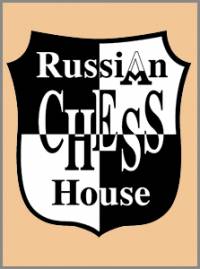 The life of a chess player in the system. Memories of the grandmaster
Author:
The life of a chess player in the system. Memories of the grandmaster
Author:
Averbah 45.00 $ -
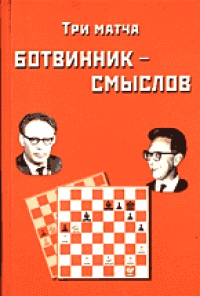 Три матча Ботвинник-Смыслов
Author:
Три матча Ботвинник-Смыслов
Author:
Botvinnik 45.00 $ -
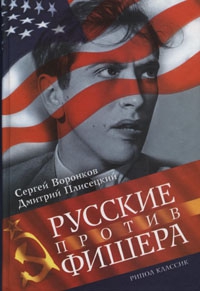 Russians vs Fisher
Author:
Russians vs Fisher
Author:
Voronkov 65.00 $ -
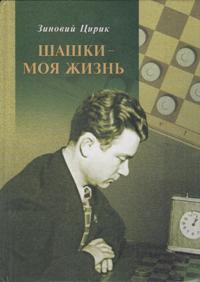 Checkers is my life
Author:
Checkers is my life
Author:
Ciric 87.50 $ -
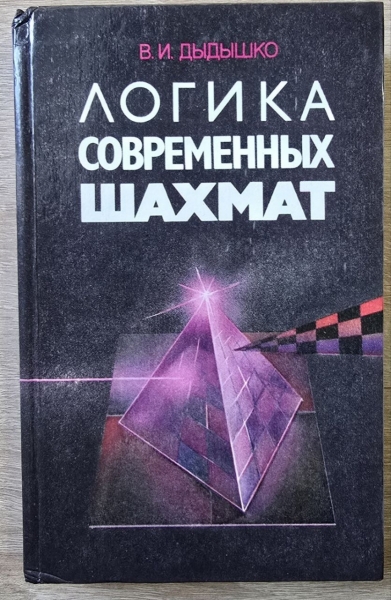 The logic of modern chess
Author:
The logic of modern chess
Author:
Dydyshko 72.50 $ -
 Siegbert Tarrasch. The Queen
Author:
Siegbert Tarrasch. The Queen
Author:
Tarrash 72.50 $ -
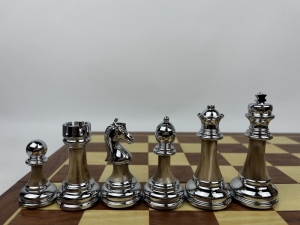 High quality acrylic metal heavy chess pieces with wooden board
202.50 $
High quality acrylic metal heavy chess pieces with wooden board
202.50 $
-
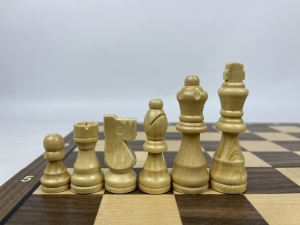 Wooden magnetic Staunton chess with a lock (silver)
56.25 $
Wooden magnetic Staunton chess with a lock (silver)
56.25 $
-
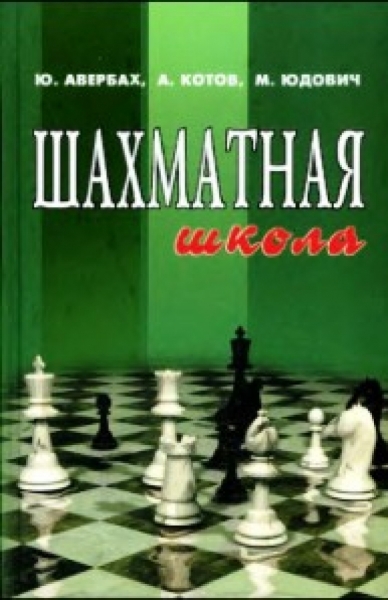 Chess school
Author:
Chess school
Author:
Averbah 15.00 $ -
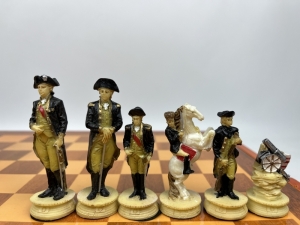 The chess set of The Chessmen. US war - Great Britain
325.00 $
The chess set of The Chessmen. US war - Great Britain
325.00 $
 Русский
Русский  Английский
Английский 